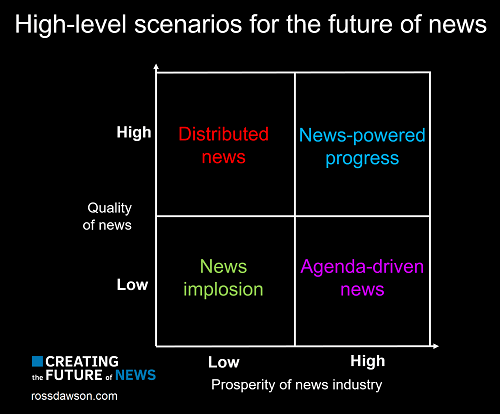Four Scenarios to Guide Pathways to a Prosperous Future for the News Industry
The higher the degree of uncertainty, the greater the value of using scenarios.
One of the deepest uncertainties today is the future shape of the news industry, which certainly faces deep challenges from both producer and consumer perspectives.
However it is feasible that the news industry can find its way to both strength both financially and in terms of social contribution.
This publication is framed around how we can create a positive future for news. Generating some simple scenarios on different possible high-level outcomes for the industry can help industry participants to consider both what they believe is most likely, and what they believe is possible.
Two of the key uncertainties in the future of news are:
- The quality of news; and
- The prosperity of the news industry.
Mapping these two variables gives us four quadrants as shown below.

Exploring these high-level scenarios allows us to examine our beliefs on what is likely or possible in the future of news. I will lay out what I see as possible across these quadrants.
You may have different opinions; in fact the true value of these scenarios is in helping to consider what you see is likely or possible in the future of news.
Distributed news
High news quality | Low industry prosperity
It is certainly plausible that we move to a world in which individuals have access to high-quality news but news organizations do not prosper. This would almost certainly be significantly based on crowdsourcing and the application of Artificial Intelligence (AI).
Crowdsourcing is not just user-generated content. In a workshop on Crowdsourcing for Media I ran in New York I identified 12 applications of crowdsourcing to news, including investigation, data gathering, fact checking, copyediting, and metadata tagging. It is also important to note that crowdsourcing is not always unpaid, as many in the media seem to think. It is participation by many people, sometimes experts, to achieve superior or more efficient results.
Blockchain could prove to be an excellent platform for getting and rewarding participation. The startup Civil provides an intriguing example of how this may work, particularly in supporting talented individual journalists.
AI is of course already being used to support journalists in structured reporting such as on financial reports and sports results. While there is significant uncertainty how fast this will progress, it is highly feasible that experienced journalists supported by AI will be able to focus their capabilities on the domains where deep investigation and insights are needed.
There are a variety of other ways this scenario could come to pass, including technological and structural mechanisms that could see efficient news delivery.
Agenda-driven news
Low news quality | High industry prosperity
On the face of it this scenario is highly unlikely, potentially implausible. Surely if the news industry is prosperous it will have sufficient resources to generate high-quality news?
This is certainly likely. However, there is the possibility that news organizations become primarily driven by specific political or social agendas, thus leading to an impoverished news landscape. It appears this trend is already developing. This could be accentuated if audiences continue to be polarized by political stance, requiring news organizations to make choices on their coverage.
Another situation that could lead to this scenario is that the companies that are reaping the most rewards from the news landscape are failing to invest in quality news, even though that could support their profitability.
News implosion
Low quality news | Low industry prosperity
This is the great fear of the last decade and more, that the rapid erosion of financial resources at news organizations leads to decreasing news quality and in turn to reducing audiences and revenue in a particularly vicious cycle. It is easy to point to the demise of many news organizations and deteriorating quality at many others as headcounts and budgets have been sliced.
This is indeed a plausible scenario, which many people seem to be taking almost as a given. However, any solid futures methodology examines the responses to trends. Responses to this scenario developing include the concerted efforts by many to drive higher quality news through technological solutions, philanthropy, crowdfunding, and other approaches.
Increasing industry prosperity could come on the other side of a dark valley in which many existing structures for news creation are lost, allowing a fresh start for new and more contemporary business models unencumbered by legacy cost structures and audience positioning.
News-powered progress
High quality news | High industry prosperity
In this world a virtuous cycle of high-quality news feeds industry prosperity and the ability to improve the news landscape to one that is substantially better than we have ever had before. Hopefully, but not necessarily, this would help create a better-informed, more proactive society that shapes a more positive future for humanity in fraught times.
This would likely to be supported by new technologies, broader distribution, high audience engagement, and broad participation in news creation to support the work of news professionals.
However there are potentially many paths and scenarios, all quite different in their detail, that could lead to this quadrant being realized.
Starting with the belief that a positive future of news is possible
The intent of my work on creating the future of news is to explore the potential paths to a world of higher quality news and higher industry prosperity. This will undoubtedly be better than one in which the industry doesn’t prosper, not least in supporting the highest possible quality of news.
The first step to creating a positive future of news is to believe it is possible. It cannot be done without that belief. That doesn’t mean that it will be inevitable or even that it will be easy, simply that it is conceivable.
From that belief we can explore how we might get there, and as an industry and society take the actions most likely to create it.
